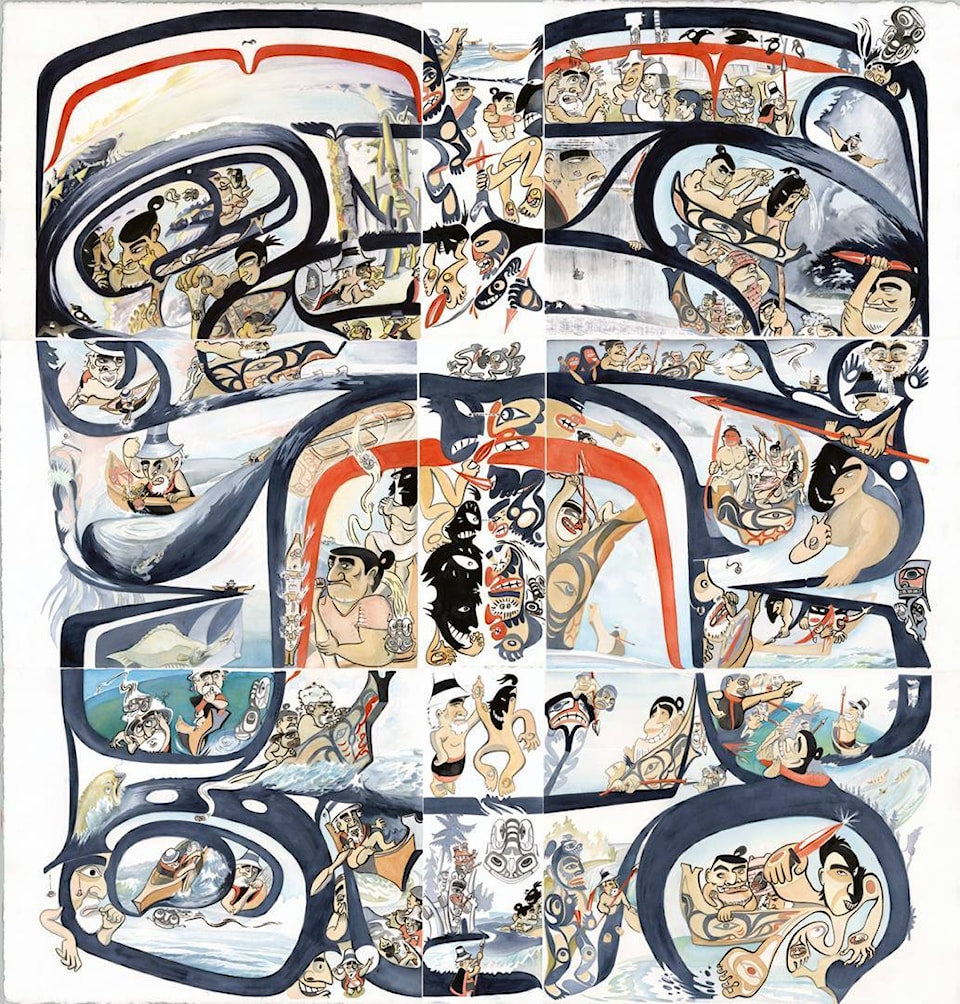When is the right time to tell the old Haida story of a war upset by a fly?
Given all the fool talk about another nuclear war, another Middle East war, or even the return of forestry spats here on island, Michael Nicoll Yahgulanaas said the ancient story fits right now.
War of the Blink is Yahgulanaas’ latest Haida manga — a book that blends pop and Haida art, illustrated in a style inspired by Japanese comic books.
Set in a time before Canada, his book retells the story of an ultra-fast war between the Haida and a great canoe of warriors who invaded from the coast.
Not only does the war end in the actual blink of an eye, what follows the fighting is a now centuries-old tradition of peace-making feasts between the Haida and their coastal cousins.
It was over such a dinner that Yahgulanaas gave an early copy to one of their hereditary chiefs on the Haidas’ behalf.
“I think the story demonstrates the complexity and sophistication of relationships in our part of the world,” Yahgulanaas said.
Each page of War of the Blink is taken from a larger mural Yahgulanaas painted to tell the story.
The action is framed by heavy brush strokes that evoke Haida formline. And for a war story, the central character is a funny guy — a sleepy, middle-aged fisherman named Gunee who happens to look a lot like Yahgulanaas himself.
That kind of “everyman” character is rare in most Western war stories, Yahgulanaas said.
“The maligned yeoman only turns up in the story if he happens to be a prince in disguise,” he said.
“It’s Good versus Evil, a white-hatted cowboy and a black-hatted cowboy, and the Indian doesn’t even count because he’s background.”
It’s the same simple, immature vision of the world that so often dominates politics, he added.
After 27 years working with the Council of the Haida Nation and the Old Massett Village Council — years when Haida Gwaii made its name as a place of line-crossing collaboration — Yahgulanaas got a frontline look at a better way, one he said Haida Gwaiians would do well to remember in the current dispute over forestry.
“At some point, I think the next stage is for Haida Gwaii collectively say to the Ministry of Forests, ‘Maybe you guys should just go,’” he said.
“Take your licences your entire system and regulatory structure out of here, and run the whole thing on the basis of a community forest.”
Yahgulanaas grew up in Massett with several traditional versions of the story in War of the Blink.
When he set out to do his own retelling, he wanted to make it as easy as possible for everyone to read and relate to.
“At home, in our families, our communities, we look at the work and see layers and layers of meaning,” he said.
“But when it moves off our community and into Canada, they look at it and they see a couple of layers.”
Some layers also get misperceived, he said, because of the “imaginary Indian” that was perpetuated for so long in Canada, in residential schools, and the world at large. But right now, Yahgulanaas said there is a liberating moment, a chance to step outside that stereotype.
In the art world, boundary-pushing artists like Jim Hart, 7idansuu, are winning recognition outside what he calls the “ethnicity bubble.”
In New York’s Metropolitan Museum of Modern Art, one of Yahgulanaas’ works is on display in the contemporary art section — the first piece by a living Indigenous artist that references an Indigenous tradition but isn’t set apart in an Indigenous gallery.
“The challenge became, how to take the form and make it so accessible that Canadians could look at it to see a bit of themselves?” Yahgulanaas says.
“Through that, they see, ‘Oh yeah, we’re the same species. Oh yeah, so maybe we should just kinda be nice. Let’s try to be nice for a while, let’s try it out.’”
